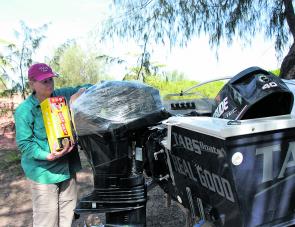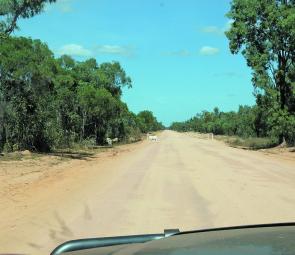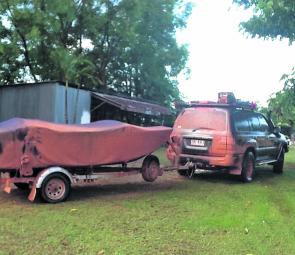There is no question that Cape York is an iconic fishing destination. The fishing is right off the scale in many places simply because the 24/7 pressure that fish endure in southern Queensland is non existent. The local population is small enough to hardly make a dent in fish stocks and visitor numbers are never excessive due to the extensive gravel roads on the Cape. No 4x4 means no go.
Camping is enjoyable at this time of year when we can enjoy upgraded minimum temperatures and although a bit rugged in many areas it all adds to the charm, and the challenge.
We had a great trip to Weipa last June so this year we saddled up again for a 5,500km round trip towing the 4.3 m TABS Bullshark with 40hp E-Tec on it’s maiden voyage north. Our trip was quite different: and has prompted this article.
First question is always, is a boat worth the effort? Sure, there are plenty of fish to be taken from the shore in many spots around Weipa, Seisia and other locations on the eastern side of the Gulf but a boat – if you can get it there- will make a huge difference. There are so many reef areas within 1-2km of the shore and during our two and a half week sojourn I saw an 18kg cobia, a 14kg Spaniard, 12kg trevally, several big cod, ample coral trout all coming across the gunwales of the Bullshark with countless tuna and queenies up to a metre also netted. Each day we launched we had a nice fat mangrove jack, coral trout, threadie or golden snapper stashed in the live well for dinner. Barra? We caught stacks of them, but not many legal sized fish.
But getting a boat to Weipa takes thoughtful planning. The bitumen road ends at Laura and from that town onwards things can go rapidly pear shaped if car and boat trailer are not prepared for 500km of gravel road travel. A tip is don’t use the boat as a box trailer and load it to the gunwales with heavy gear. The trailer is going to be doing it hard enough without overloading it. Keep the contents to lighter and bulkier items. I stored our shade cloth ground covers, the 12 x 12 fly for our camp, our dome tents, plus other lighter gear including rod tubes. All boat batteries were removed and stored within the vehicle. The Minn Kota electric had to go in the boat because of its size and was carefully wrapped in the ground sheets and stored flat.
The 500 odd kilometres of gravel on the Peninsula Development Road (PDR) between Laura and Weipa airport is a lottery. I found it could vary from good to reasonable to very bad within any 20km stretch, and do so repeatedly as topography changed from wash outs and steep gullies to hills where large rocks are embedded in the road surface and cannot be smoothed down. Overall, the gravel section is also well endowed with big fat clouds of red dust which seems to work its way into every possible area due to the sheer hours involved in travel.
Dust, however, was not the concern on the last trip northwards, it rained. Unseasonal, sure, but the 246km from Laura to Coen (where we had pre-booked accommodation at the Coen Guesthouse) turned to a quagmire of mud with potholes filled with muddy water ready to splash onto the windscreen. Fortunately, the boat had a full cover from Rowland Street Boat Trimmers, so only the trailer and cover grew in size as the red mud gathered. 40kph for over six hours saw us limp into Coen well after dark.
Our vehicle was equipped with a Korr 90 Watt, 8100 lumens light bar on the roof rack and when the Toyota’s headlights covered in mud and slush the light bar atop the roof rack kept us moving. We’d have been in dire straights without that light bar.
My trailer, like most used on many punt style craft, originally came equipped with side skids and a series of central rollers on upright T-pieces to support the keel. Suspension comprised of slipper-style leaf springs. I saw the set up as ideal for bitumen work, somewhat risky for the gravel section with its pot holes and corrugations. Repeated jolting might well force the rollers down and out of alignment, or a spring set to slip out of a hanger with the alloy hull then at risk of damage. And, of course, all this without the slightest hint of what is going on as the car progresses purposefully on its way, the driver alert for another washout or badly corrugated section.
A trailer upgrade prior to last year’s journey saw the side support skids doubled in length, slipper springs replaced by shackle springs, the central rollers and supports upgraded several sizes and fixed onto a rectangular bed for total security plus the winch post with extra bracing for utmost rigidity. To avoid the cleaning chores involved last year when the trailer was oxidised red, this year I sprayed the whole trailer with silicon spray (the lubricant stuff) and most of the red colour came off at first wash, the rest largely removed with hot water, Handy Andy detergent, and a normal scrubbing brush.
To guard against dust intrusion into the outboard on both forward and return journeys we took steps to eliminate it, again on good advice. Although the boat cover also comprised a zippered cover for the 40 E-Tec we took the precaution of removing the cowling from the engine and thoroughly covering the upper section with several layers of Glad Wrap. With the cowling in situ we wrapped it all again, along with the lower leg. In all this was a wise tactic as there was some dust within the cover, good as it was, when we removed it but none had made its way into the engine.
The PDR is wide and visibility is very good. If an approaching vehicle is creating a lot of dust there will always be ample time to slow down until it passes. There’s always the temptation to speed up given the 100kph limit but one needs to be on the alert as cattle and feral pigs wander across without warning. In all, though, once the Wet is over, the PDR is like any other gravel road in our country, at times it’s good, others it’s bad depending upon the road works being carried out at the time. I saw it as no bar to a trip north, just something to factor in along with fuel stops, accommodation or camping areas en route. In next month’s issue I will carry on with some tips to make the camp site as comfortable as possible, especially if one is away from recognized camping grounds, and some useful fishing tips as well.
Reads: 7511
The Korr 90 Watt light bar in action; it proved a vital item during muddy and wet conditions at night.

The Korr light bar, with it’s 8100 lumens output, is a virtual necessity for extended night travel.

Dust intrusion into an outboard engine’s intake area and other sensitive parts can be avoided with a few applications of good old Glad Wrap.

Brassy trevally like this one taken by wife Denise make taking the boat to the Gulf worth while. Note the big fish on the HDS 7 as well.

The Gulf has plenty of reef areas to offer fish like this 18 kg cobia taken and released by Steve Shephard.

Our trailer’s upgraded central roller system and skids can be easily noted in this shot.

Travelling on the PDR requires some caution: wandering cattle are a common nuisance.

Red mud aplenty! The boat cover and car have been washed here, at Coen, so we could at least approach them without getting mud on our clothing.




